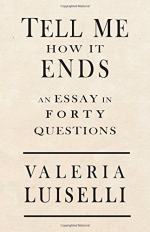
|
| Name: _________________________ | Period: ___________________ |
This test consists of 15 multiple choice questions and 5 short answer questions.
Multiple Choice Questions
1. What tool does Luiselli's family use to navigate during their road trip?
(a) A car GPS system.
(b) A map.
(c) Handwritten notes from prior research.
(d) A navigation app on their phones.
2. In what language is the list of memory-joggers written upon the whiteboard on Luiselli's first day interviewing child refugees?
(a) English.
(b) Arabic.
(c) Russian.
(d) Spanish.
3. Luiselli creates a metaphor for the similarities among the children's stories by depicting the scribbling on the whiteboard as what object?
(a) A blanket.
(b) A brick.
(c) A light bulb.
(d) Scaffolding.
4. With whom does Luiselli live?
(a) Her husband and his son and her daughter.
(b) Her husband and his son.
(c) Her husband and her two daughters.
(d) Her husband and their two sons.
5. What is NOT a duty performed by Luiselli in her role as an interpreter?
(a) Recording the children's answers.
(b) Getting coffee for her partner.
(c) Interviewing the children in court.
(d) Translating the children's answers for lawyers.
6. Luiselli describes Manu's police report as ending with what kind of sentiment by the police?
(a) A vague promise to set up a sting operation.
(b) A vague promise to prosecute.
(c) A vague promise to investigate.
(d) A vague promise to conduct a few interviews.
7. How old was Luiselli's niece at the time she accompanied her aunt to Luiselli's first day as an interpreter in the New York immigration court?
(a) 24.
(b) 12.
(c) 19.
(d) 32.
8. Luiselli states unequivocally that all child refugees from Mexico and Central America travel with whom?
(a) A humanitarian worker.
(b) A coyote.
(c) A parent.
(d) A sibling.
9. Who created the screening questionnaire used by Luiselli in her interviews with child refugees?
(a) The Mexican government.
(b) The Immigrant Children Advocates' Relief Effort.
(c) The United States Department of Homeland Security.
(d) Amnesty International.
10. Luiselli is a resident of what city at the time of the essay's writing?
(a) New York City.
(b) Detroit.
(c) Mexico City.
(d) Chicago.
11. Luiselli states that most of the children involved in the refugee crisis of 2014 are from all but which of the following countries?
(a) Honduras.
(b) Guatemala.
(c) El Salvador.
(d) Venezuela.
12. Luiselli explains that "what happens to children during their journey through" what country "is worse than what happens anywhere else" (24)?
(a) Mexico.
(b) The United States.
(c) Guatemala.
(d) Honduras.
13. Whose point of view does Luiselli claim is always ignored within the struggle to understand the refugee crisis?
(a) The child refugees.
(b) The Republicans.
(c) The Democrats.
(d) The parents of the child refugees.
14. During what season does Luiselli set out on a road trip with her family?
(a) Winter.
(b) Summer.
(c) Fall.
(d) Spring.
15. What is NOT a way in which Luiselli's family learns information about the developing child refugee crisis during their road trip?
(a) Newspapers.
(b) Online searches.
(c) Calls from family members in Mexico.
(d) Radio.
Short Answer Questions
1. In what year was the Indian Removal Act approved by Congress?
2. How many South and Central American migrants were found at the site of a mass grave in 2010?
3. Luiselli states that much later, she had come to understand that what she and her niece "were really doing that morning [on the first day of their new jobs] was providing" what "for organizations dealing with an emergency" (38)?
4. Within what state is Luiselli's family when they first hear "about the wave of children arriving, alone and undocumented, at the border" (11)?
5. The process by which a child refugee is asked questions during an intake interview is called what?
|
This section contains 542 words (approx. 2 pages at 300 words per page) |

|




